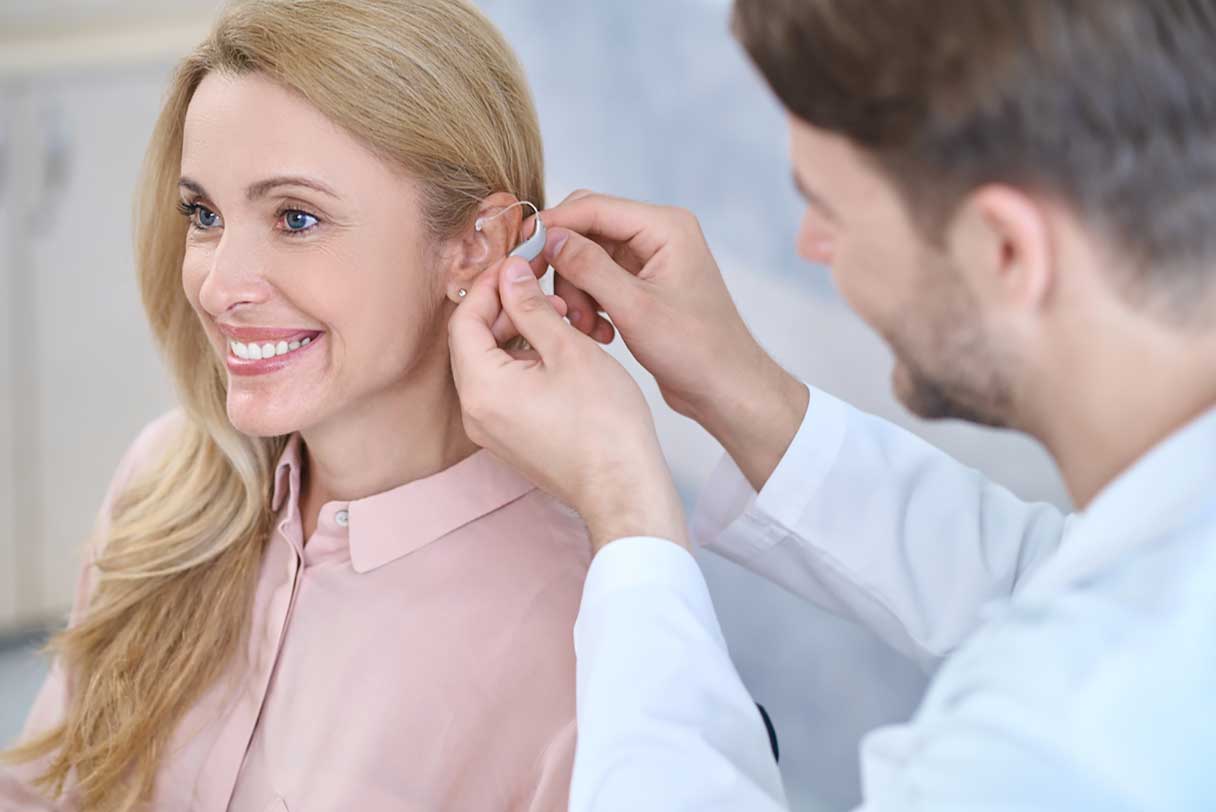Do you have trouble understanding what other people are saying? Do you turn up the volume on your TV loud enough that you disturb your neighbors? If so, you may be one of the approximately 15% of American adults who report trouble hearing.1
Good news: In most cases, hearing aids can significantly improve your ability to hear, and recent advancements in hearing aids can provide better hearing care, comfort and performance — and they can even help reduce your risk of developing conditions like dementia.2
Here, we discuss how hearing aids work, different types of hearing aids, average hearing aid costs and how to choose the best hearing aid for you.
How Hearing Aids Work
The basic function of a hearing aid is to amplify sounds so that they’re audible (but not too loud) while minimizing background noise. Sound waves enter through a microphone, which converts acoustic signals into electrical signals.3
Hearing aid controls let you conveniently adjust the volume and microphone settings. Hearing aids also improve the ability for a person to understand speech, and recent technology makes it easier to hear clearly in noisy environments.3
Key parts of a hearing aid
The different parts of hearing aids include:4
- Microphone. Picks up the sounds around you and sends them to the computer processor
- Sound processor (digital hearing aids). Receives sounds, analyzes and converts them to digital signals and then transmits them to the speaker
- Amplifier (analog hearing aids). Increases the loudness of the sound before transmitting it to the speaker
- Speaker/receiver. Sends the sounds to your ear, allowing you to hear them
- Battery. Powers the device and allows it to function properly; may be rechargeable or disposable
Different Types of Hearing Aids
There are several types of hearing aids — some worn in the ear canal and some worn behind the ear.4 They don’t all perform in the same way, and choosing the best hearing aid style for you can depend on factors like severity of hearing loss, ear shape, age, price and personal preferences. Your audiologist can help recommend the best kind for you during your appointment with them.
1. Behind-the-ear (BTE) hearing aid
This type of hearing aid hooks over your ear and sits behind it. It’s suitable for those with all types of hearing loss, including severe hearing loss.3 Behind-the-ear hearing aids work well for people of all ages, especially children, whose ears are still growing.4
While they are visible when worn, they are durable and fit most people. They also may come with rechargeable batteries.5
The national average cost* of a behind-the-ear hearing aid is $1,562 per device but can range from $1,233 to $3,037, depending on size, selected features and any customization.6
Some pros and cons of BTE hearing aids are outlined in the table below.5
| Pros | Cons |
|---|---|
| Comfortable to wear | Device is visible |
| Easier cleaning and maintenance | Larger in size than other styles6 |
| Longer battery life | Picks up a lot of external noise |
2. In-the-ear (ITE) hearing aid
These custom-made hearing aids fill some or most of the outer part of your ear and work best for those with mild to severe hearing loss.5 They feature longer-lasting batteries, volume controls and directional microphones for better hearing amplification. However, they are visible when worn and may become clogged with ear wax.5
The national average cost* of an ITE hearing aid is $1,411 per device, but the cost can range from $1,086 to $2,567, depending on size, customization and your location.6
Some pros and cons of ITE hearing aids are outlined in the table below.5
| Pros | Cons |
|---|---|
| Better sound quality, less external noise | Can be damaged by earwax buildup |
| Comes in skin tone shades to blend in | Can cause a plugged-up feeling |
| Comfortable | Less suitable for growing children3 |
| More discreet than BTE hearing aids6 | Short battery life due to size |
3. Open-fit (mini BTE) hearing aid
Open-fit hearing aids, also known as mini behind-the-ear hearing aids, are similar to full-size BTE aids but are smaller and less visible. They sit behind the ear and have a tube that inserts into the ear canal.4
These aids work best for those with mild to moderate high-frequency hearing loss. That’s because these aids leave the ear canal open, allowing you to naturally hear low-frequency sounds while amplifying the higher-frequency sounds.6
Expect to pay about the same as other types of BTE aids: The national average cost* of an open-fit (mini BTE) hearing aid is $1,513 per device, but it can range from $1,179 to $2,808, depending on the design and features, as well as any fitting services needed.6
4. In-the-canal (ITC) hearing aid
These types of hearing aids are small and unobtrusive, fitting partially inside the ear canal. They are best for adults with mild to moderate hearing loss.6 Because of their small size, they are less powerful and use small disposable batteries that may need frequent replacing.5
The national average cost* of an in-the-canal hearing aid is $1,818 per device, but it can range from $1,397 to $3,370, depending on the device’s size, technology and customization.6
Some pros and cons of ITC hearing aids are outlined in the table below.5
| Pros | Cons |
|---|---|
| Custom made | Less powerful3 |
| Discreet appearance | Smaller size may be difficult to handle4 |
| Often compatible with wireless connectivity6 | May not filter out background noise due to small size |
5. Completely-in-canal (CIC) or mini CIC hearing aid
Smaller than ITC hearing aids, these are the least conspicuous of hearing aids.5 Some, known as mini CIC or invisible-in-canal hearing aids, are not visible at all because of their small size. They won’t pick up wind noise, but they use small batteries that run out quickly.5 These hearing aids work best for those with mild to moderate hearing loss.6
The national average cost* of a CIC hearing aid is $1,917 per device, but it can range from $1,474 to $3,704, depending on size, features and specialized fittings.6
6. Receiver-in-canal (RIC) hearing aid
The receiver-in-canal type fits similarly to the behind-the-ear style but with the speaker (receiver) in the ear canal itself. The open fit lets some natural sound in, and it comes in a variety of shapes and colors.5 This device is also known as a receiver-in-the-ear (RITE) hearing aid.6
These are smaller and less noticeable than behind-the-ear styles and typically come with rechargeable batteries and are compatible with wireless technology.5
The national average cost* of a receiver-in-canal hearing aid is $1,966 per device, but it can range from $1,513 to $3,783, depending on the technology level and custom fittings.6
7. Surgically implanted hearing aids
For those dealing with profound hearing loss, removable hearing aids may no longer help. In these cases, your doctor may recommend a surgically implanted hearing aid, including:
- Bone-anchored hearing aid (BAHA). These aids attach to the bone behind the ear and send sound vibrations to your inner ear through your skull. Part of the implant is placed under the skin, and you wear the other part externally in your ear. BAHAs are medical devices used for people with middle ear problems or mixed hearing loss, or those with no hearing in one ear.7 The national average cost* of a bone-anchored hearing system is $11,601, but can range from $9,259 to $21,864, depending on brand, fitting costs, location and other factors.6
- Cochlear implants. For this type of hearing aid, a surgeon implants a receiver and electrode system in your inner ear. An externally worn microphone, sound processor and transmitter system sends signals to the implanted components.7 The national average cost* of cochlear implants is $51,072, but it can range from $39,475 to $98,195, depending on surgical fees, follow-up care and other factors.6
- Middle ear implants. Implantable middle ear hearing devices (IMEHD) help transmit sound to the inner ear. A surgeon attaches these aids to one of the bones of your middle ear to help send vibrations to the inner ear. IMEHDs are medical devices generally used for sensorineural hearing loss.7 The national average cost* of middle ear implants is $16,318, but it can range from $12,513 to $29,875, depending on brand, surgical fees and other factors.6
8. Analog hearing aids
Analog hearing aids convert sound waves into electrical signals and amplify them, making them louder and easier to hear. You can program them for different types of environments, like relaxing at home or being in the middle of a crowded theater.3 The national average cost* of a pair of analog hearing aids is $1,354 but can range from $1,061 to $2,252, depending on the brand of the hearing aid, specialist services and location.6
9. Digital hearing aids
Digital hearing aids are slightly more complex and generally more expensive than analog ones. They convert sound waves into a code of numbers, similar to binary computer code, and then back into sound waves before amplifying them. Because the code produced contains information about the frequency of the sound waves, it also lets you program the hearing aid to amplify sounds only within the frequencies you can’t hear, rather than all of them.3
Digital hearing aids will automatically respond to your environment and adjust their volume and programming, depending on whether you’re in a crowded space or sitting at home. This allows digital hearing aids to be more customized to each user’s needs.8
The national average cost* of a pair of digital hearing aids is $2,114, but the cost can range from $1,650 to $4,155, depending on brand, features, customization and other factors.6
Other Types of Hearing Devices
In addition to hearing aids, other devices are available to help you hear better in various settings.
- Assistive listening devices (ALDs). Designed to help you hear everyday sounds, ALDs are FDA-regulated as medical devices and electronic products. ALDs are typically used in public spaces, including auditoriums, movie theaters, houses of worship and meeting rooms. Microphones are placed near the sound source, which transmits sound to a receiver worn by the listener. Background noises are minimized, and the volume can be adjusted as needed by the listener.7
- Personal sound amplification products (PSAPs). These devices were developed to amplify sound for non-hearing-impaired listeners. They may be used for outdoor activities such as bird watching or indoors to help hear soft sounds or distant conversations. PSAPs are not intended to aid or compensate for hearing impairment like hearing aids and are classified as electronic products and not medical devices.7
Do Hearing Aids Restore Hearing Loss?
Hearing aids can’t completely restore hearing or stop the progression of hearing loss. But with consistent use, they can greatly enhance your quality of life by reducing background noises and amplifying sounds that were inaudible before.9
Benefits of Hearing Aids for Hearing Loss
Unlike the hearing aids of years past, today’s hearing aids are small in size but much more powerful than their predecessors. Hearing aids have come a long way in recent years, from technology to comfort and style.
Most importantly, they’ve been shown to significantly enhance the social, emotional and physical well-being of people with mild to severe hearing loss.10 That’s because they allow you to go back to socializing with friends and family without the need to worry about not understanding what anyone around you is saying.
Do You Need a Hearing Aid?
If you’re concerned about your or a loved one’s hearing or are experiencing any signs of hearing loss like the ones below, schedule an appointment with an audiologist. Your hearing care provider can give you a comprehensive hearing evaluation and ask you about any family history of hearing loss. The provider will also discuss treatment options, which may include hearing aids.
Common signs of hearing loss
Any of these signs, or a combination of them, may indicate hearing loss:10
- Difficulty following group conversations
- Difficulty hearing people who aren’t looking directly at you
- Experiencing signs of tinnitus (ringing in your ears)11
- Feeling tired at the end of the day from straining to hear
- Frequently asking people to repeat themselves
- People seem to be mumbling or talking softly
- Turning up the TV, radio or phone volume to hear properly
Tips to Choose the Right Hearing Aid
When choosing a hearing aid, there are several factors to consider because they are a financial investment. These include:
- Degree of hearing loss. Not all hearing aids are created equal. For instance, an ultra-compact completely-in-canal (CIC) or mini CIC may only be suitable for mild to moderate hearing loss. If you have a more severe hearing loss or deafness in one ear, you will likely need a behind-the-ear (BTE) device.3
- Lifestyle and activity. If you are very active and enjoy lots of physical activities, you will want to choose a device that will stay in place no matter what you are doing. The CIC or mini CIC may be good options for this, and even a mini BTE may be right for you, depending on your level of activity.3
- Price. Prices vary significantly across different devices. For example, the national average cost* for personal sound amplification products is $135, while the average cost* for a pair of digital hearing aids is $2,114.6
- Programmable settings. Some types of hearing aids allow you to choose from a variety of pre-programmed settings to allow you to hear better in different types of environments (like theaters or while in an office setting). Some devices offer tinnitus masking, which helps to reduce the negative effects of tinnitus.11
- Retail availability. Over-the-counter (OTC) hearing aids will now be available directly through retailers — both online and in person — for adults with mild to moderate hearing loss. You could save money by purchasing one this way instead of through an audiologist’s office.12
Although OTC options are available, there are still benefits to consulting an audiologist before you make your final decision on which hearing aid is right for you. An audiologist can help you choose the device that works best for you, based on your specific needs and lifestyle. They are also able to make adjustments, service or even repair devices that they sell. In addition, loaner hearing aids may be available while yours are being repaired.
Find the Hearing Aid That’s Right for You
If you are experiencing signs of hearing loss, make an appointment with your doctor or a hearing specialist. They’ll help you select a hearing aid that’s suitable for your lifestyle, budget and level of hearing loss.
Financing Ear Care With the CareCredit Credit Card
The CareCredit credit card can help you pay for hearing care, including regular hearing tests, screenings and more.** Use our Acceptance Locator to find a hearing specialist near you that accepts CareCredit. Continue to invest in your wellness journey by downloading the CareCredit Mobile App to manage your account, find a provider on the go and easily access the Well U blog for more great articles, podcasts and videos.
In addition to hearing care, you can also use your CareCredit credit card for dentistry, cosmetic, pet care, vision, health systems, dermatology, pharmacy purchases, spa treatments and so much more within the CareCredit network. How will you invest in your health and wellness next?
Author Bio
Steve Marshall, D.N.P., M.S.N., B.S.N, R.N., has over 30 years of nursing experience, with diverse expertise in clinical leadership, ER, oncology, infectious disease and more. Using his clinical knowledge, he has written for top publications including Everyday Health, the National Council on Aging and Next Avenue. He is dedicated to combining his extensive nursing knowledge with well-crafted storytelling to help those seeking factual medical information.







